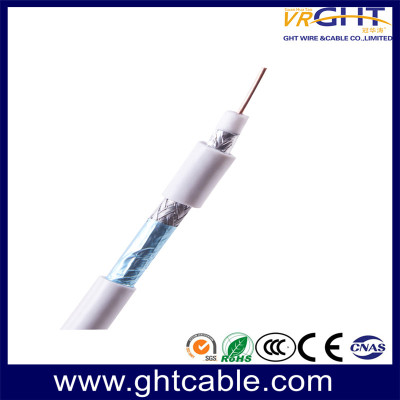
RG6 Vs RG59: Which Coaxial Cable Should You Use?
In today's digital world, where high-speed data transmission, HD video, and signal reliability are critical, selecting the right coaxial cable can make a significant difference. Two of the most common types used in CCTV systems, satellite TV, and broadband internet are RG6 and RG59. Though they appear similar, these cables differ in performance, structure, and use cases.
In this comprehensive guide, we'll explore the core differences between RG6 and RG59 coaxial cables, examine their technical characteristics, and help you determine the best cable for your specific project. We'll also explain why working with a reputable supplier like VRGHT ensures long-term quality, durability, and consistent performance.
What Is a Coaxial Cable?
A coaxial cable is a type of electrical cable designed to transmit radio frequency (RF) signals with minimal interference. It is widely used in applications such as television broadcasting, internet connections, CCTV surveillance, and satellite communications.
The structure of a coaxial cable typically includes:
- A central conductor (usually made of copper or copper-clad steel)
- A dielectric insulating layer
- A metallic shield, which may consist of foil and/or braided wire
- An outer protective jacket
The design ensures stable impedance, reduces electromagnetic interference (EMI), and enables effective signal transmission over various distances.
Structural Differences Between RG6 and RG59
While both RG6 and RG59 share the same basic coaxial structure, they differ significantly in dimensions, shielding, and materials—all of which affect performance.
1. Cable Thickness and Conductor Size
RG6 cables are generally thicker than RG59. The central conductor in RG6 is typically 18 AWG, whereas RG59 uses a 20 or 22 AWG conductor. The larger conductor allows RG6 to transmit signals more efficiently over long distances.
Additionally, RG6 cables have a thicker dielectric insulator, which further improves signal integrity by reducing leakage and maintaining impedance stability.
2. Shielding Configuration
Shielding is crucial in environments with high EMI, such as near power lines or electronic equipment. RG6 often comes with dual or quad shielding—consisting of multiple layers of foil and braided shielding—providing superior protection against signal interference.
RG59 typically has single or basic dual shielding, which may be sufficient for low-frequency, short-distance signals but is inadequate in demanding environments like HD video systems or commercial broadband installations.
3. Jacket Material
Both cables are available with various jacket types depending on the intended environment. For example:
- PVC jackets for indoor use
- PE or UV-resistant jackets for outdoor or direct burial applications
- Plenum-rated jackets for fire safety in air-handling spaces
Signal Transmission and Frequency Handling
The most critical distinction between RG6 and RG59 lies in how they handle signal transmission—particularly over long distances and high frequencies.
RG6 Coaxial Cable:
- Supports frequencies up to 3 GHz
- Lower signal attenuation, making it suitable for long cable runs
- Ideal for satellite TV, HD digital video, and high-speed internet
- Maintains strong signal integrity over 100 meters or more
RG59 Coaxial Cable:
- Effective up to 1 GHz
- Suffers higher signal loss over distance
- Primarily used in short-range analog CCTV and legacy video systems
- Not recommended for HD signals or modern digital applications
If your application involves high-resolution cameras or fast data, RG6 is almost always the better option.
Application Scenarios: When to Use RG6 vs RG59
Choosing between RG6 and RG59 depends heavily on the specific application and environmental factors. Here's how to evaluate their suitability:
Recommended Use Cases for RG6:
- HD CCTV Systems (HD-SDI, HD-TVI, AHD)
- Satellite and Cable TV
- Broadband Internet (modem to wall jack)
- Long cable runs in commercial or multi-room buildings
- Digital audio and video distribution
Recommended Use Cases for RG59:
- Analog CCTV Systems (short distance)
- Legacy video devices
- Tight installation areas requiring flexible cable
- Budget-limited projects where signal quality is less critical
As modern technology continues to evolve toward digital, high-resolution systems, RG6 has become the industry standard for most new installations.
Cost vs Performance: Is RG6 Worth the Investment?
It's true that RG59 is typically cheaper than RG6, which makes it attractive for budget-conscious buyers. However, choosing RG59 to save money can result in long-term performance issues, particularly in systems requiring reliable high-frequency transmission.
Here's why RG6 offers greater value:
- Fewer signal dropouts and distortions
- Lower maintenance and replacement costs
- Compatibility with current and future digital systems
- Longer lifespan and better shielding for harsh environments
By investing in RG6, you reduce the risk of needing costly re-installation or technical troubleshooting later.
Why Choose VRGHT for Your Coaxial Cable Needs?
At VRGHT, we specialize in manufacturing and supplying premium-grade coaxial cables, including RG6, RG59, and other transmission solutions for CCTV, satellite, TV, and broadband applications.
We understand how crucial signal quality and long-term reliability are in modern installations, which is why we commit to strict production standards and continuous innovation.
What sets VRGHT apart:
- We use high-purity copper conductors to ensure low signal attenuation and stable connectivity.
- Our coaxial cables feature advanced shielding structures (including quad shielding) for superior EMI resistance.
- Every product undergoes rigorous quality control aligned with ISO, CE, and RoHS standards.
- We offer customization options for different environments—indoor, outdoor, direct burial, or plenum-rated.
- Our experienced team provides technical support and fast logistics to meet project deadlines worldwide.
Whether you're building a digital surveillance system, rolling out fiber-coax hybrid networks, or upgrading home entertainment infrastructure, VRGHT provides the coaxial cable solutions you can rely on.
Conclusion: Which Cable Should You Use?
To make the right decision, always start by considering signal frequency, distance, and interference conditions. In most modern setups, especially those involving HD signals or broadband internet, RG6 is the superior and future-ready choice.
If you're dealing with a short-distance analog system and budget is a key concern, RG59 can still be appropriate—but it may limit future upgrade potential.
Most importantly, ensure the cable you choose—RG6 or RG59—is manufactured to high standards. When quality and performance matter, VRGHT is the supplier you can trust to deliver durable, high-performance coaxial cable solutions that stand the test of time.










Leave a comment